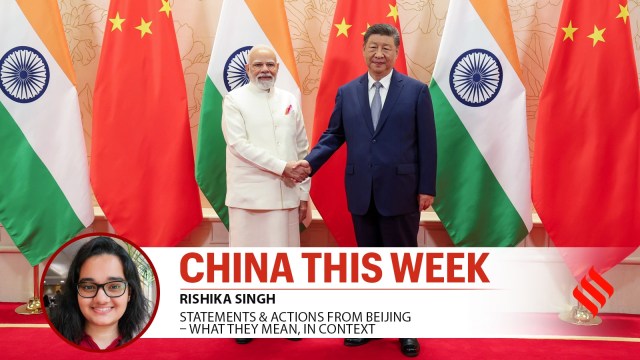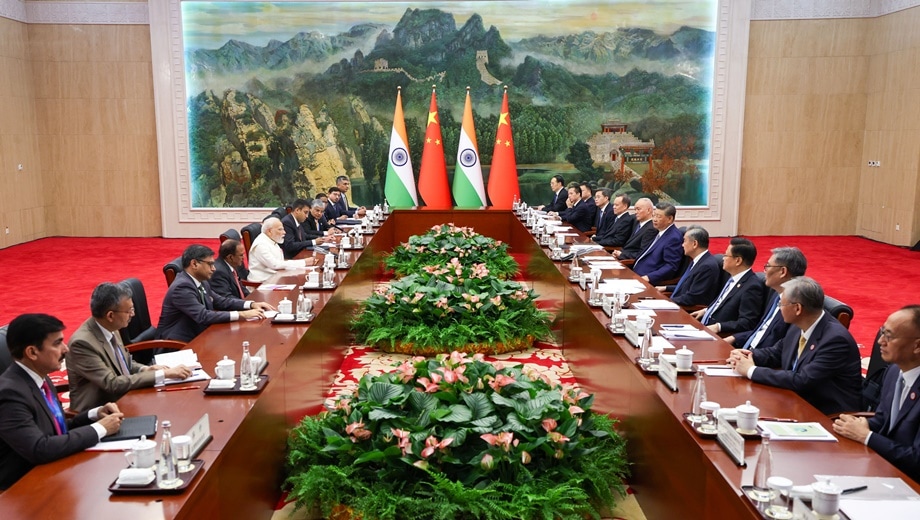Prime Minister Narendra Modi met Chinese President Xi Jinping in the city of Tianjin in China on Sunday (August 31), in what was his first visit to the country in seven years.
“Had a fruitful meeting with President Xi Jinping in Tianjin on the sidelines of the SCO Summit. We reviewed the positive momentum in India-China relations since our last meeting in Kazan. We agreed on the importance of maintaining peace and tranquility in border areas and reaffirmed our commitment to cooperation based on mutual respect, mutual interest and mutual sensitivity,” the PM posted on X.

The prime minister will be in China for another day for the two-day Shanghai Cooperation Organisation (SCO) summit, which will also see Russian President Vladimir Putin and Pakistani Prime Minister Shehbaz Sharif in attendance.
However, the Indian statement after the bilateral meeting specifically said that the relationship should be viewed only from the perspective of the two countries in question. It also mentioned the border question, trade ties, and more. Here is a closer look.
The context
The meeting comes amid important developments in the bilateral relationship since October 2024, where Modi and Xi met on the sidelines of the BRICS (Brazil, Russia, India, China and South Africa) summit in Kazan, Russia.
The ties took a nosedive following the 2020 clashes between the two militaries in Galwan, Ladakh, near the disputed Line of Actual Control (LAC) that serves as the de facto border between India and China. This was the first conflict with China in four decades in which Indian soldiers were killed. Four personnel of the Assam Rifles were killed in t and 20 soldiers died in Galwan in 2020. Among other things, the government halted Chinese investments in India as an immediate response.
Fast forward to 2024, when an agreement was announced for disengagement in the border areas in relation to the 2020 conflict, marking a thaw. On October 21, 2024, Indian Foreign Secretary Vikram Misri said that India and China had agreed on disengagement and patrolling arrangements along the LAC. Two days later, the leaders met in Kazan.
Story continues below this ad
 The meeting in Tianjin, China. (X/narendramodi)
The meeting in Tianjin, China. (X/narendramodi)
The Indian press release stated, “The two leaders affirmed that stable, predictable, and amicable bilateral relations between India and China, as two neighbors and the two largest nations on earth, will have a positive impact on… peace and prosperity.”
Since then, a range of steps have been taken for normalising ties — resumption of the Kailash Mansarovar Yatra in Tibet, India opening up visas, high-level ministerial visits, and more.
At the same time, there remains significant scepticism, owing to the two sides’ long-standing differences on the key issue of the border dispute. Notably, Xi visited India in October 2019 as part of an Informal Summit, and barely six months later, the Galwan clashes took place. Issues such as the nearly $100 billion trade deficit in favour of China have also complicated the task of achieving lasting cooperation.
More recently, China’s diplomatic and economic support for Pakistan, particularly selling its weapons systems that were used during Operation Sindoor, has been an area of concern.
Story continues below this ad
Within China, official comments and articles on state media websites have recently welcomed the PM to China, and criticised framing it as India “hedging” in light of the United States imposing tariffs on its goods. However, there is also a strong view that India is mainly seeking to balance its own relationships. Manoj Kewalramani, Chairperson, Indo-Pacific Studies Programme, the Takshashila Institution, Bengaluru, told The Indian Express: “Basically, there is a feeling that India is seeking easing (of the relationship) because it is realising that it needs China. But it will continue to hedge and be untrustworthy.”
The statements
Here are a few highlights from the statements issued after the meeting:
*On the border issue: Both sides’ releases talk about maintaining peace and tranquility in the border areas. As Kewalramani wrote in his newsletter ‘Tracking People’s Daily’, “the Chinese view is that one must “not let the border issue define the overall China-India relationship.”
The Indian readout, however, says: “Prime Minister underlined the importance of peace and tranquility on the border areas for continued development of bilateral relations.”” This, he wrote, shows some difference in priorities.
Story continues below this ad
*On strategic autonomy in foreign affairs: The Indian readout said, “India and China both pursue strategic autonomy, and their relations should not be seen through a third country lens.”
It can be read in the context of how Beijing has historically viewed India’s policy of non-alignment with suspicion. Chinese leaders have often believed that India was aligning with the US or Russia as part of their strategy to strengthen their position against China in the region. The comment underlines India’s stance of pursuing an independent foreign policy, also given the recent US tariffs.
*On trade: The Indian readout mentions “the need to proceed from a political and strategic direction to expand bilateral trade and investment ties and reduce trade deficit.” While it marks a positive in that trade has been mentioned as a focus area, Kewalramani noted that it stops short of agreeing to anything substantial.
He wrote that during the second Informal Summit in 2019, the two sides had announced that they would set up a high-level mechanism headed by Finance Minister Nirmala Sitharaman and then Vice-Premier Hu Chunhua to look at trade, investment and services. Ultimately, it never transpired owing to the border clashes and the Covid-19 pandemic.
Story continues below this ad
Additionally, industrial overcapacity has also been a concern in China, of late. Xi has spoken about the need for Chinese manufacturers to correct it, as it is leading to severe competition in pricing and firms undercutting each other. Practices like “dumping”, where goods are sold for cheaper in another country, are also becoming an irritant in China’s ties with many countries. However, curbing overcapacity is easier said than done and will adversely impact the Chinese economy in the short run.
The upshot
China mentioned the need to “firmly grasp” that the countries were “partners and not rivals”, and underlined the Five Principles of Peaceful Coexistence, also known as Panchsheel. The Indian side, for its part, noted the need for mutual respect, mutual interest and mutual sensitivity. The prime minister also met Cai Qi, a member of the Chinese Communist Party’s Standing Committee of the Politburo. The seven-member body is the most powerful political organisation in the nation, involved in making key decisions.
These signs may indicate both countries reviewing and supporting the normalisation process thus far, amid an external situation that has incentivised closer ties. However, no major agreement has transpired from the meeting. The slight but important differences mentioned in the statements also reiterate that for the two neighbours, even in the best of circumstances, deepening the relationship comes with many challenges.



 The meeting in Tianjin, China. (X/narendramodi)
The meeting in Tianjin, China. (X/narendramodi)




































